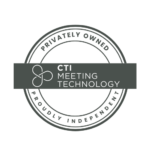The events industry is constantly evolving, and it can be difficult to keep up with new trends and technologies. However, event planners and organizers have to embrace the rapidly changing event landscape and stay ahead of the curve to provide successful meetings.
We have compiled 10 key event trends to help you captivate your audience and create more memorable scientific meetings. So, continue reading to learn how you can use the latest event trends to your advantage as an organizer in 2023:
1. Growth of hybrid events:
In-person events are back, but they look way different than before. Due to technological innovations, growing globalization, and the impact of COVID-19, hybrid events have experienced significant growth. This new event format combines the best of both worlds: the collaboration opportunities of in-person meetings and the boundless accessibility of virtual experiences.
There is no doubt that after experiencing the many benefits that the virtual component offers, organizers are sticking to the hybrid format, or incorporating virtual elements into their in-person events.
Hybrid events have grown in popularity thanks to their ability to cater to diverse attendee preferences and circumstances, transcending geographical barriers. This inclusivity fosters a more global and diverse audience, enriching discussions and fostering knowledge-sharing in the scientific community. Hybrid events are also more cost-effective; organizers can save money on variables like venue rental and catering.
But perhaps the main reasons to implement virtual elements or embrace the hybrid format is their inherent flexibility and interactivity. Attendees can choose the format that best suits their needs. This can be especially important for people who have scheduling conflicts or who live in different time zones. Even when carrying out a fully in-person meeting, organizers can rely on a software that offers interactivity tools such as polls, surveys, or Q&A sessions, to keep attendees engaged. What’s more, these tools ensure that all participants have a voice, leading to a dynamic atmosphere that drives meaningful conversations and collaboration.
If you’re considering planning a hybrid event, there are a few things you need to keep in mind. First, make sure your event platform is user-friendly for both in-person and virtual attendees. Second, provide clear instructions for how to attend the event in both formats. Third, offer interactive features that allow virtual attendees to participate in the event. And finally, monitor the event to make sure that both in-person and virtual attendees are engaged, and analyze after the meeting to implement further improvements in the future.
There’s no need to rely on multiple partners! You can find providers that offer an integrated solution for hybrid meetings.
2. Personalized attendance experience:
One of the main goals for event organizers is crafting a memorable and impactful meeting experience for attendees, presenters, and everyone involved. This objective is especially important for scientific events, where attendees are often looking to learn about a specific topic or to connect with other experts in their field.
Event organizers can break down barriers between attendees and content by embracing personalization, ensuring that every participant feels seen and valued. This leads to increased participation, more networking opportunities, positive feedback, and overall higher event satisfaction.
There are many ways to personalize events. Organizers can use meeting data to create targeted content or offer personalized networking opportunities. Creating a welcome email that includes the attendee name and topics of interest is an easy way to do this. If your software of choice has the right features, you can also offer personalized session recommendations according to past content that attendees have interacted with.
By personalizing scientific events, organizers can create a more engaging and memorable experience for attendees. This can help attract more participants and build meaningful relationships, which impacts the overall success of the meeting.
3. Data-driven decision-making for planning and management:
Data has evolved as a powerful driving force behind the successful outcome of event planning and management. By leveraging the insights derived from data analytics, event planners can access a great amount of information about every part of the event, leading to an improved attendee experience.
Organizers can collect data in many different ways, including registration forms, surveys, or feedback forms. Social media, website analytics, and email marketing campaigns can also be good sources of attendee data and behavior. Once you collect the data, you need to analyze it to identify trends and patterns. Here is where a meeting software that offers automated reports comes in handy, simplifying this task and providing relevant insights about the event.
Not only that, organizers can also benefit from real-time event performance updates. Event planners can access key metrics on-demand, enabling them to make quick and data-backed adjustments during the meeting itself.
4. Sustainability in event planning:
In recent years, there has been a growing emphasis on sustainability in event planning. Organizers are now encouraged to adopt sustainable practices and implement eco-friendly initiatives in their events due to many factors: the increasing awareness of the impact events have on the environment, the growing demand for sustainable products and services, and attendees’ desire to participate in sustainable meetings.
Thankfully, it is easy to incorporate ways to make your events more sustainable. Here are a few examples:
- Choose an eco-friendly venue. Look for a venue that has committed to sustainability. This could include a venue that uses renewable energy or recycles waste, for example. If possible, consider pivoting your event to a virtual or hybrid format, to minimize the environmental impact of your meeting. In fact, a study by Nature Communications shows that carbon footprint can be lowered by 94% just by switching from in-person to virtual conferences.
- Reduce your environmental impact. Choose sustainable products and services for your events. This could include using recycled paper, vegan food choices, and public transportation options.
- Educate your attendees. Let your attendees know about your commitment to sustainability by providing information about sustainable practices in your event materials and at the conference venue.
By making small changes to your events, you can help reduce their environmental impact and make a positive change in the world.
Read our article with tips and tricks to make your meeting more environmentally-friendly.
5. Enhanced networking opportunities:
Scientific events are the perfect occasion for experts, researchers, and health professionals to come together, share insights, and collaborate on relevant projects. Hence, why it is important that meeting organizers allocate specific times to dedicate to networking in the event agenda. Lunch or coffee breaks can be the perfect excuse to encourage your attendees to interact with each other.
Travel restrictions and geographical barriers are no longer an excuse for a lack of networking! As an organizer, you can leverage virtual networking features such as live chats, networking lounges, or virtual Q&A sessions to guarantee all your attendees are included in the conversations. Virtual networking not only ensures inclusivity, but also offers a higher potential for collaboration and knowledge sharing.
Virtual networking is here to stay, and can serve as a strategic asset for organizers. By embracing virtual networking, facilitating interactions among attendees, and leveraging interactive event technologies, organizers can craft enhanced networking opportunities that go beyond physical boundaries and enable participants to beneficial connections that foster innovation and scientific progress.
6. AI and automation tools for event management:
Artificial intelligence – more commonly known as AI – is undoubtedly one of 2023’s hottest topics. Organizers can take advantage of AI-powered solutions and automation to revolutionize their events.
Event management involves many repetitive tasks. With automation, these manual processes can be streamlined and optimized, allowing organizers to save time and focus on other important tasks like strategic planning and attendee engagement. Automation also contributes to seamless coordination and smooth execution of all event elements.
AI technologies can also help with personalization, tailoring event content, schedules, and recommendations to suit attendee’s preferences. This degree of customization enhances attendees’ meeting experience and increases engagement, leading to the long lasting impact of the event.
Even after the conference, AI and automation continue to play a crucial role by providing comprehensive evaluations of event performance, highlighting areas of success and potential improvements. These insights serve as a valuable guide for future events.
There is no doubt that AI-powered technologies are going to be very relevant in the events industry this 2023, and will continue to change and transform. If you want to know more about how to leverage AI for scientific conferences, check our blog post including tips.
7. Gamification and interactivity tools for engagement:
Attendees are now looking for more engaging and interactive experiences at events. This 2023, event organizers are utilizing interactivity tools and gamification elements to boost attendees’ engagement, foster participation, and increase excitement into every aspect of the conference. By using these innovative tools, scientific events are redefined as engaging experiences that foster engagement and leave a lasting impact on attendees.
Incorporating game-like elements, such as points, leaderboards, or badges, transform scientific elements and learning into a playful and enjoyable experience. Gamification elements also create a sense of competition, encouraging attendees to actively participate in every part of the event. Gamification and game-based learning also helps with the educational goal of the event, helping attendees to retain the information presented better (check this article by the University of Waterloo).
Counting with a reliable software that includes interactivity tools is essential to ensure a seamless experience. Organizers can use polls, real-time Q&A sessions, or live chats features to encourage audience participation and engage directly with speakers and presenters.
8. Inclusivity and accessibility:
Inclusivity and accessibility have become crucial foundations of successful meetings. Organizers can benefit from a wider reach by making their events more accessible and inclusive, while attendees can enjoy the whole event without worries.
Here are some things that meeting planners can do to create more inclusive and accessible events:
- Ensure the event venue is accessible to people with disabilities: This means providing wheelchair-accessible entrances, restrooms, and seating. If not possible, make sure to provide virtual access for attendees that might not be able to participate in person.
- Provide sign language and captioning for deaf and foreign attendees.
- Offer transcripts of presentations for blind or visually impaired attendees.
- Be careful with the language used in event materials: Avoid using language that is offensive or discriminatory.
Virtual events transcend geographical boundaries, making scientific gatherings more accessible to individuals all around the world. Embracing virtual event options provides the opportunity to participate to attendees that may face travel or time limitations, ensuring that no one is excluded from the event’s content and networking opportunities.
Creating an inclusive and accessible meeting is no longer an option but a responsibility for event organizers. Using virtual meeting software turn scientific events into platforms that foster participation, collaboration, and learning.
9. Cybersecurity and data privacy:
The shift to virtual meetings has unlocked a world of opportunities for connectivity and accessibility, but it also came with many challenges and exposed new security risks. Event organizers are more aware than ever of the need to safeguard sensitive information and protect against potential cyber attacks. This is vital to ensure a safe environment for all participants in a meeting, specially in a virtual environment.
Virtual meetings involve the collection and storage of attendee data, which makes ensuring data privacy of utmost importance. Organizers must comply with relevant data protection regulations, and establish and communicate clear policies regarding the collection, storage, and use of attendee information. Using strong passwords, encrypting data, or implementing access controls are some of the ways organizers can protect attendee privacy.
Openly communicating security measures to attendees and other participants fosters trust in the event and the organization itself, so don’t skip this step! Furthermore, by addressing cybersecurity concerns and providing information about data privacy practices, you can ensure attendees that their safety and privacy are top priorities.
The virtual event landscape is always evolving, and so are cyber threats. It is important that organizers adopt a proactive approach, constantly updating their security practices to stay ahead of potential risks. Event planners must conduct regular security assessments, vulnerability testing, and implement updates to security protocols to maintain a strong and safe meeting environment.
10. High demand for innovative content:
Traditional and boring PowerPoint presentations are no longer enough for events in 2023. Attendees crave dynamic and interactive content that facilitates learning and fosters collaboration. Event organizers must explore new technologies and creative approaches to redefine knowledge sharing in scientific meetings.
Incorporating multimedia elements such as infographics, video content, and interactive visuals help capture the audience attention and convey complex concepts with clarity. By blending different media formats, presenters can create engaging sessions that have a positive impact on attendees.
Organizers can also cater to diverse attendee preferences with innovative content delivery, such as live-streaming and on-demand access. These features provide flexibility, enabling attendees to engage with content at their convenience and increasing the meeting life cycle.
By using a software that offers data-driven insights, event organizers can recommend tailored content to attendees based on their interests and backgrounds. Personalization ensures that attendees get content that aligns with their interests and expertise, making the meeting experience more relevant and rewarding.
Utilizing these techniques allow meeting organizers to create more engaging and memorable experiences for attendees. This contributes to improving the overall success of the event and promoting the value of scientific research.
—–
Now you should have a good overview of the event trends that are shaping the industry in 2023. However, this is a fast-changing industry, so it is crucial that event planners are always up-to-date on the latest trends. As a meeting organizer is important to take into consideration your attendees’ feedback, be creative, and not be afraid to experiment and try new ideas in your events.
If you are looking for a software that helps you with these tasks, CTI’s solution might be the best choice!
You can benefit from a wide range of features, including interactive tools, and 24/7 technical support for users, among others!
Are you interested in learning more about how CTI Meeting Technology software can help you plan successful scientific events? Book a call with one of our experts.
Or visit our website to learn more about our software’s innovative features and how it can benefit your scientific events.






